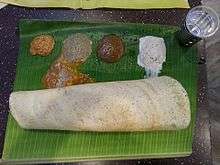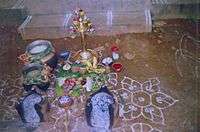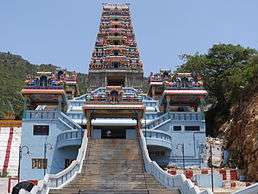Culture of Coimbatore
Popularly called as the "Manchester of South India", the culture of Coimbatore is distinctly different from that of any other city in India. Being a cosmopolitan city, the culture of the city reflects its diverse population which has resulted in a unique blend. Though it is generally considered a traditional city, Coimbatore is more diverse and cosmopolitan than other cities in Tamil Nadu. Traditional music, dance and all other art forms of Tamil Nadu are very popular in the city. One can find a unique blend of culture from traditional foods to fast foods, from ancient temple architecture to modern high-rises and from classical music and dance to the growing nightlife in the city. Coimbatore and its people have a reputation for entrepreneurship.[1][2]
Music and arts
The city conducts its own music festival every year.[3] Art, dance and music concerts are held annually during the months of September and December (Tamil calendar month – Margazhi).[4] The heavy industrialisation of the city has also resulted in the growth of trade unions.[5]
People
The city's population is predominantly Hindu, along with a small group of Muslim[6] population. Christians, Sikhs and Jains are also present in small numbers.[7][8][9] Coimbatore also has a large number of Kannadigas / Telugus,[10] Malayalis,[11][12][13] mainly from Palakkad and North Indians,[14] mainly Gujaratis,[15] who are engaged in trade and commerce. During the 1970s the city witnessed a population explosion as a result of migration fuelled by increased economic growth and job opportunities.[16][17] Around 8% of the city's population lives in slums.[18]
Religion
There are numerous temples in and around the city including the Perur Patteeswarar Temple, Konniamman temple, Thandu Mariamman temple, Vazhai Thottathu Ayyan temple, ISKCON Temple, Eachanari Vinayagar Temple, Karamadai temple, Marudamalai Murugan temple, Loga Nayaga Shani Eswaran shrine, Astamsa Varada Anjaneyar temple, Panchamuga Anjaneya temple and Dhyanalinga Yogic Temple.[19] The Mariamman festivals, at the city’s numerous Amman temples, are major events in summer.[20] The mosques on Oppanakara Street and Big Bazaar Street date back to the period of Hyder Ali.[21] Christian missions date back to 1647 when permission was granted by the Nayak rulers to set up a small church in Karumathampatti 12 km (7.5 mi). It was destroyed by Tipu Sultan’s army resulting in a new church in 1804. In 1886, Coimbatore was constituted as a diocese after bifurcating with Puducherry. Sikh Gurudwaras and Jain Temples are also present in Coimbatore.
Cuisine

Coimbatore cuisine is predominantly south Indian with rice as its base. However, the population of Coimbatore is multi-cultural due to the influx of migrant population from various regions of the country. Most locals still retain their rural flavour, with many restaurants serving food over a banana leaf. North Indian, Chinese and continental cuisines are also available. Mysore pak (a sweet made from lentil flour and ghee), idly, dosa, Halwa (a sweet made of different ingredients like milk, wheat, rice).The Annapoorna Gowrishankar Hotels is a gem of this region known for its high quality vegetarian food and their Sambar ( The sambar for all its branches around Coimbatore are prepared in a single large batch and then delivered to the branches, thus the taste remains consistent). Biryani is also popular among the locals. Apart from this Coimbatore has a very active street food culture, thanks to the migratory North Indian population that settled down here a few generation ago, in fact a streetfood that is popular all over Tamil Nadu The Kaazhaan has its origins here in Coimbatore, it is usually prepared by simmering deep fried mushrooms( usually chopped mushroom) in a spicy broth, until it reaches a porridge like consistency and served sprinkled with chopped oinions and coriander leaves.
Language
Kongu Tamil is the dialect of Tamil language that is spoken majorly in the city. It is originally known as "Kangee"`[22] or "Kongalam"[23] or "Kongappechu". The speciality of Kongu Tamil is the use of the alveolar ற - Tra/Dra (as in the English word track) instead of retroflex T/D (ட) of standard Tamil. For example, 'ennuDaya' (mine) of standard Tamil is pronounced enRa in the Kongu dialect. Additionally the use of guttural nasal (ங்) that sounds "ng" as in the English word Gang, is more prevalent in Kongu Tamil, leading to situations where the grammar of Kongu Tamil would not fit into the grammar of standard Tamil (as laid down in authoritative treatises like Tolkappiyam and Nannool). One of the examples is the use of ங் to end a word like வாங் "vaang", means 'come' expressed in a respectful tone, which in standard Tamil would be "vaanga". English is increasingly spoken by the educated class and other languages spoken in the city include Malayalam, Telugu and Urdu.

Festivals
Coimbatore celebrates a many festivals including local temple festivals. Thai Pongal, celebrated in the month of January, is the most important festival of and is celebrated over a period of five days. Pongal has been designated the "State Festival" for its unique celebration that is typical of Tamil Nadu. Tamil New Year signifying the beginning of the Tamil calendar usually falls in April and is celebrated widely with special poojas in temples. Being a cosmopolitan city, almost all major festivals like Deepavali, Eid and Christmas are celebrated here. Onam is also celebrated with much fanfare due to the large Malayali immigrant population.
References
- ↑ "Is Coimbatore the next BPO city?". CNBC-TV18. 5 July 2008. Retrieved 23 June 2010.
- ↑ "German state keen to share expertise with Coimbatore". Business Line. 22 June 2007. Retrieved 23 June 2010.
- ↑ "Some music lovers still travel to Chennai for cultural overdoze". The Times of India. 14 December 2011.
- ↑ "In December, all the city's a stage". The Times of India. 14 December 2011.
- ↑ "A time of troubles". Frontline. 7 March 1998. Retrieved 23 June 2010.
- ↑ "Indian Muslim Population Data". Aicmeu.org. Retrieved 2013-01-31.
- ↑ "Primary Census Abstract – Census 2001". Directorate of Census Operations – Tamil Nadu. Government of Tamil Nadu. Archived from the original on 17 February 2011. Retrieved 14 June 2010.
- ↑ "KMK plans to overcome casteist tag". The Hindu. 20 May 2009. Retrieved 23 June 2010.
- ↑ "Roots of capital". Frontline. 5 July 2008. Retrieved 23 June 2010.
- ↑ The 1971 census puts Telugu speakers at 22.95% of the total population."Census of India, 1971: Tamil Nadu". Govt of India. Retrieved 10 November 2011.
- ↑ some estimates put it as high as 40% or at 300,000Rajan, M.C (7 February 2010). "It's passion for the mother tongue not chauvinism". India Today. Retrieved 23 April 2011.
- ↑ "Majority should protect the minority". The Hindu. 4 October 2009. Retrieved 23 June 2010.
- ↑ "Keralites' wishes take flight on Paramount's wings". The Indian Express. 8 November 2008. Retrieved 23 June 2010.
- ↑ "Residential space: Coimbatore spins a growth story". The Economic Times. 17 January 2010. Retrieved 23 June 2010.
- ↑ "Providing quality education". The Hindu. 24 September 2006. Retrieved 23 June 2010.
- ↑ Elangovan, K. "Site Suitability Analysis using GIS for Coimbatore City". GIS Development:. September 2005:. Retrieved 21 May 2010.
- ↑ Urban labour market structure and job access in India: a study of Coimbatore. International Institute for Labour Studies,. 1990. pp. 4–7. ISBN 978-92-9014-468-7.
- ↑ "There are 195 slums in 23 major identified locations inside the corporation limits with a total population of around 352,219, which include BPL population as well. Around 8 percent of the total population reside in slums."(2005 figures) page.86
- ↑ "Temples of Coimbatore". The City Visit. Archived from the original on 26 January 2010. Retrieved 23 June 2010.
- ↑ "Rajagopuram for Kovai Koniamman temple too". The Indian Express. 2 March 2010. Retrieved 23 June 2010.
- ↑ Madras District Gazetteers: Coimbatore. Superintendent, Govt. Press,. 2000.
- ↑ "In the southern part of Mysore the Tamil language is at this day named the Kangee, from being best known to them as the language of the people of Kangiam". Cf. Wilks: Mysore 1, 4n. 55.
- ↑

